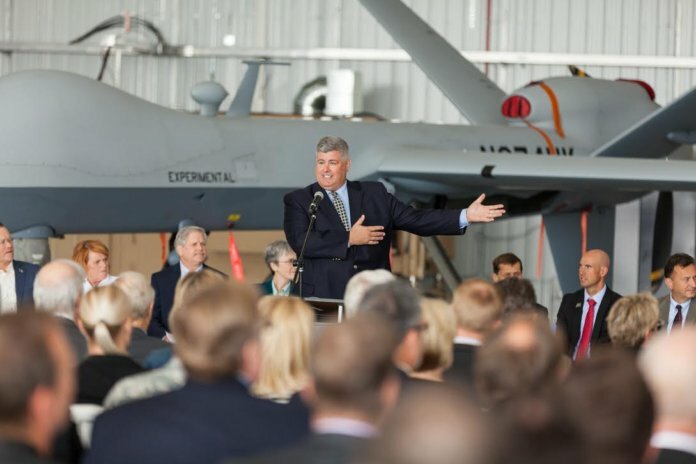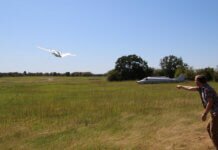Large unmanned aircraft systems (UAS) have begun flying beyond the visual line of sight (BVLOS) of the operator at Grand Sky, a commercial UAS-focused research and development park in North Dakota.
At an event held on Monday, Heather Wilson, secretary of the U.S. Air Force, recognized the collaborative relationship between the U.S. Air Force, Grand Forks County, Grand Sky Development Co., the Northern Plains UAS Test Site and others that made federal approval of BVLOS flights at Grand Sky possible.
Sens. John Hoeven and Heidi Heitkamp and North Dakota Lt. Gov. Brent Sanford also delivered remarks at the event, which included a BVLOS flight conducted by General Atomics Aeronautical Systems Inc. and a demonstration of the technology used to track BVLOS flights from the park.
“Flying large UAS beyond visual line of sight in the national airspace will allow the unmanned aircraft industry to demonstrate its true potential for contributing to commercial aviation operations,” says Thomas Swoyer Jr., president of Grand Sky Development Co. “It reduces the cost for operators to test and prove systems and provides the opportunity for real-world demonstrations of how unmanned and manned aircraft can share the skies safely and efficiently. Achieving federal approval for these flights was truly a group effort, and we can’t thank everyone involved enough for their hard work to make it happen.”
BVLOS flights at Grand Sky are monitored through a system that combines several methods of surveillance into one stream. One-way access to Grand Forks Air Force Base’s radar feed is linked to locally installed ADS-B Xtend and FAA NextGen systems through Harris Corp.’s RangeVue system to provide operators with real-time situational awareness of both manned and unmanned aircraft.
“As the technology partner for the detect-and-avoid system supporting Grand Sky’s safe and efficient BVLOS operations, Harris stands ready to make this inaugural flight a success,” says George Kirov, vice president of commercial UAS solutions at Harris Electronic Systems. “This partnership enables a truly integrated airspace, where commercial UAS operators and technology providers can innovate and test advanced drone technologies in a real-world environment.”
Grand Sky was the first location in the U.S. to receive regulatory permission to host commercial BVLOS test flights for large unmanned aircraft. The approximately 36-month process was led by the Northern Plains UAS Test Site, which will now also aid operators seeking certificates of authorization to conduct BVLOS flights within the approved airspace at Grand Sky.
“The milestone of removing a chase airplane from these operations is literally years in the making with multiple stakeholders from private industry, FAA and DOD coming together to find an achievable solution,” comments Nicholas Flom, executive director of Northern Plains UAS Test Site. “The persistence has paid off, and I can’t wait to have the UAS industry advance their programs in North Dakota with this approval.”
All large UAS flights from Grand Sky are launched and recovered at the Grand Forks Air Force Base runway. Initial BVLOS flights at Grand Sky will be limited to large UAS flying within 30 nautical miles of Grand Sky and will be subject to several additional FAA restrictions while flight data is accumulated to demonstrate the safety of BVLOS flights.
Grand Sky expects its BVLOS range will eventually be extended to include the entire state of North Dakota and all classes of aircraft flying at higher altitudes. The park’s surveillance system is also currently capable of supporting operations for aircraft flying within 60 miles of the radar.










